Tips
* Keeping freshwater fish outside during spring and summer is a remarkable way of keeping fish. In a way, there's much more motivation to create a natural habitat in comparison to an aquarium inside the house. For in a regular aquarium people have the urge to create a clear water biotope where one is still able to watch the fish more clearly and in general this means a less natural habitat. But once a tank is used outside and it has to blend in in the backyard... one is more urged to use vegetation which are meant for ponds and the use of other natural ornaments. And an environment like that is a much more better housing for the fish as we speak...
* Water temperature can be of importance to determine the sexes offspring. This goes specifically for livebearing tooth carps in general. When a female is kept at lower temperatures during pregnancy, a bigger male or female offspring will develop. But in case the temperature will be increased during pregnancy, it will be the other way around. I'm not specifically mentioning that lower temperatures will result in more males or females. For it depends on the kind of livebearer species which way works best. This is not a 100% guarantee that it will work for Mother Nature has got her own mind on this. But it does work most of the time.
* Breeding problems? In free nature a lot of fish are stimulated to reproduce themselves after a rain shower occurs. You can simulate this situation by refreshing some parts of the water in your tank on a frequent bases and there will be a higher ratio of spawning and mating fish.
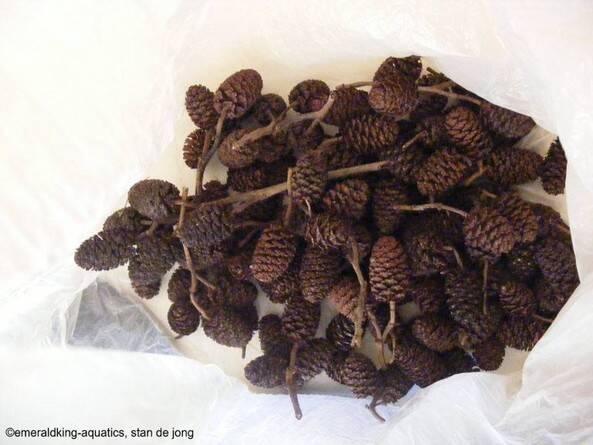
But also using dried leaves (you do have to be careful what kind of leaves you're using) will do the job. You can find them outdoors and dry them yourselves or buy them (see photo right).
But be aware that the water may get tanned. Which isn't a negative thing, btw.
* Trying to keep your fish free from fungus and making the water softer can easily be done by usiing alder plugs. Rinse them before using. Otherwise, you water will be tanned. If you don´t mid a tanned biotope, just let them float first on the water surface. Once they´ve absorbed the water, they´ll sink to the bottom.


* To keep your tank or pond free from algae or reduced from algae, you can use willow twigs.
But also using freshwater clams (mussels) can help you out with your algae growth problem.
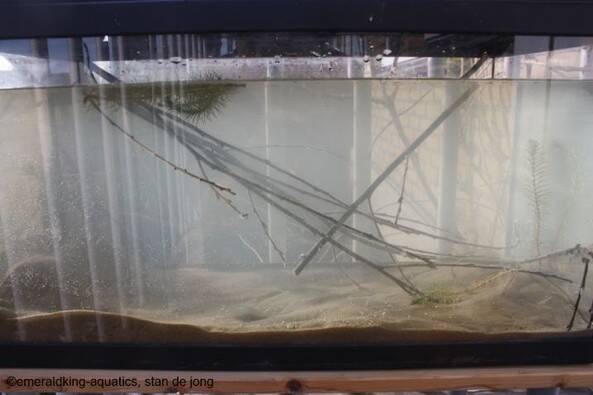
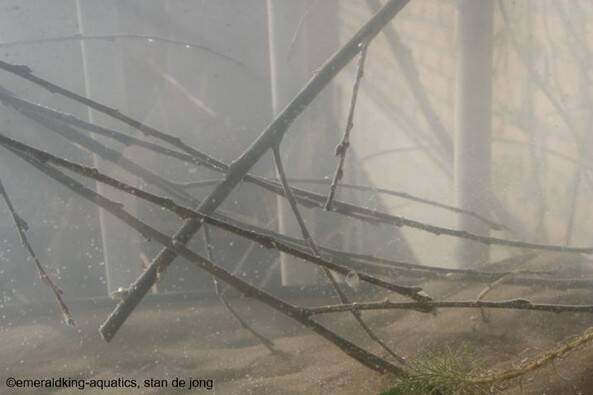
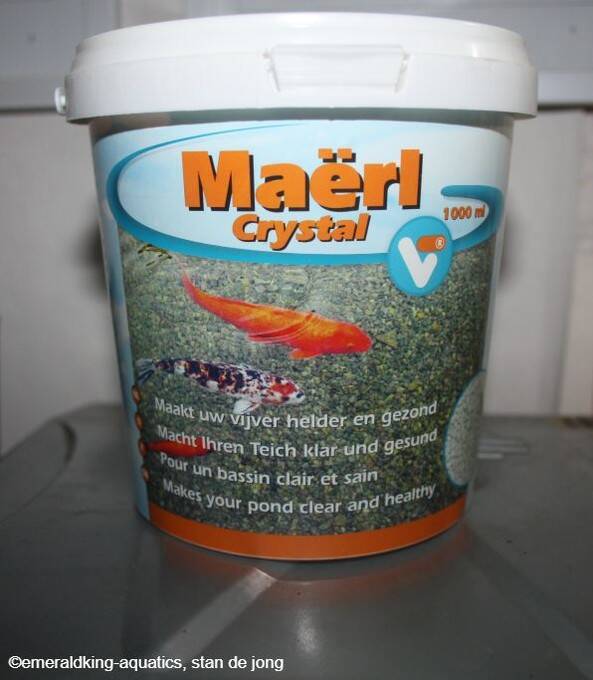
Another way to make a fish tank, tub or pond algae free or even clear, is to use maërl. Maërl is usely sold for ponds. But it works perfectly in fishtanks as well. I prefer the granulate version instead of the powder version, to avoid cloudiness of the water.
It also hardens the water, if that's desirable.
Maërl is a collective name for non-geniculate coralline red algae with a certain growth habit. In Europe maërl beds occur throughout the Mediterranean, along most odf the Atlantic coast from Portugal to Norway, and in the English Channel, Irish Sea and North Sea. The distribution of maërl is dependent on water movement, light and sdalinity concentration. Maërl beds occur in the photic zone (this is also called the sunlight zone and this is the uppermost layer of a body of water that receives sunlight). And can be found to around 30 meters depth in the British isles and up to 120 meters deep in the Mediterranean. Maërl is dredged from the sea floor and crushed to form a powder. Maërl is rich of minerals, which favors the fish.
Maërl is sold by many brands.
* If you'd to make pictures of you fish but they are to vivid to take a decent shot, try to use a photo container. You can even make one yourself. But also other small containers will do the job perfectly.


* Tank cover needed? Most of my tanks are open tanks. So, without a lid or canopy. Despite of the fact that most fish are potential jumpers, doesn't mean that they will also jump if there's no lid or canopy that is holding them back.
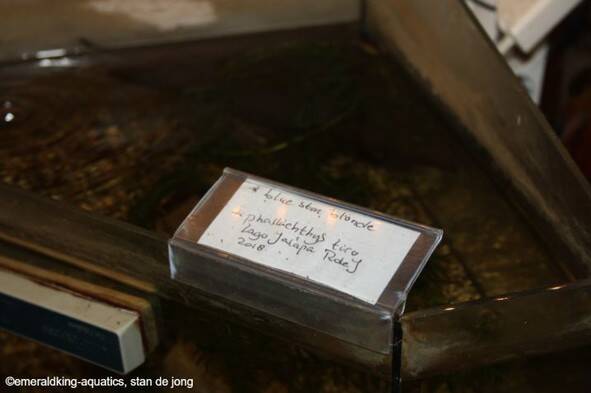
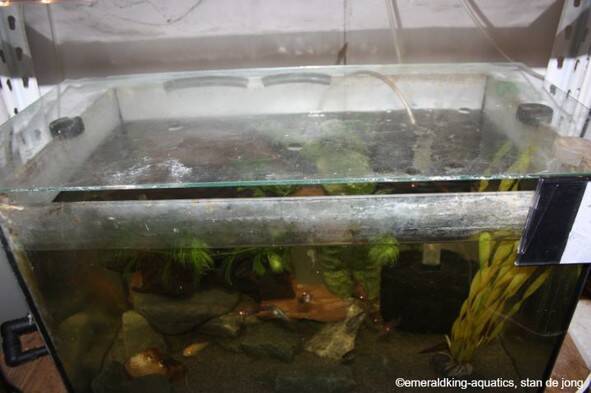
But in case the risk is a bit too high, I do use a glass pane as a tank cover. But it won't close the whole top of the tank. I always leave some open space, so the gasses can be released out of the water.

But there are also other options to make a cover with an option to let the gasses escape. Simply by using a paint grid (comes in multiple sizes) will do the job as well. It's a cheap and practical solution. Also the sizes of the openings of the grid differ depending on the size of the grid itself. So, take in consideration the size of the fish and the openings of the grid. So, they can't get through...
*How to make a gravel filter yourself...



1. Using a simple plastic cutlery tray .
2. Cut it in the right size.
3. Put the cut cutlery tray in place upside down.
4. measure the right length of this pvc pipe (Ø 32 mm/ 40 mm will do).
5. Cut the pvc pipe on the right length.
6. Place the pvc pipe on the right spot (you can glue it or put it loose on the tray.
7. Put an elbow on the pipe (doesn't need to be glued).
8. On top of the tray, gravel or substrate can be used.
9. Put an aeration stone connected to an aeration pump in the pve pipe.
10. Now you've got a functional gravel filter.
*There are many ways to separate pregnant females from the other fish or separate the newborn fry from the adults.
Overhere a simple method to get things started. Cut a piece of plasticized chicken wire. Be sure to cut the sharp endings on each side. So, it won't hurt the fish. Roll it like a tube. And be sure to push the bottom part into the sand, gravel or substrate. You can place it anywhere in the tank. I prefer to put them in the corner of a tank. The openings are big enough to let adult and young guppies (or other not too large livebearers) swim through it. But they can't rush through it in order to chase the fry. Overhere some tuxedo red guppies that won't chase their own fry, btw. But it will give the fry a place to hide to have some rest.

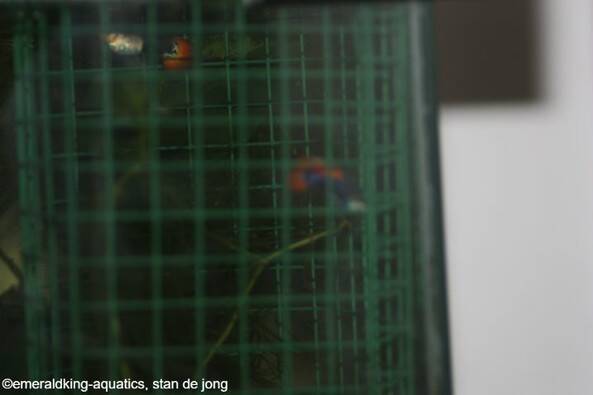
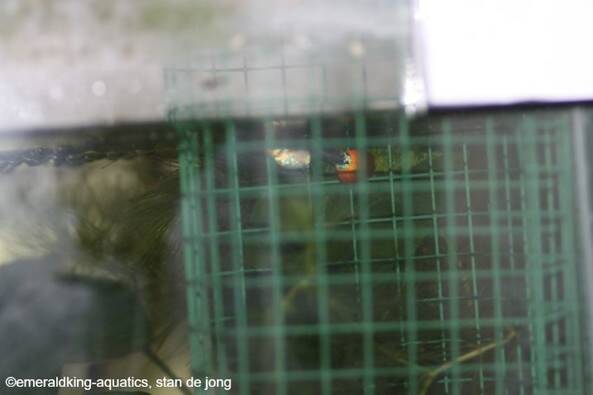
I also put some plants like hornwort in this cylinder of chicken wire. Works perfectly...
If case you're dealing with fish that are active fry eaters, you could also try making a cylinder from a gauze with smaller meshes as shown below:
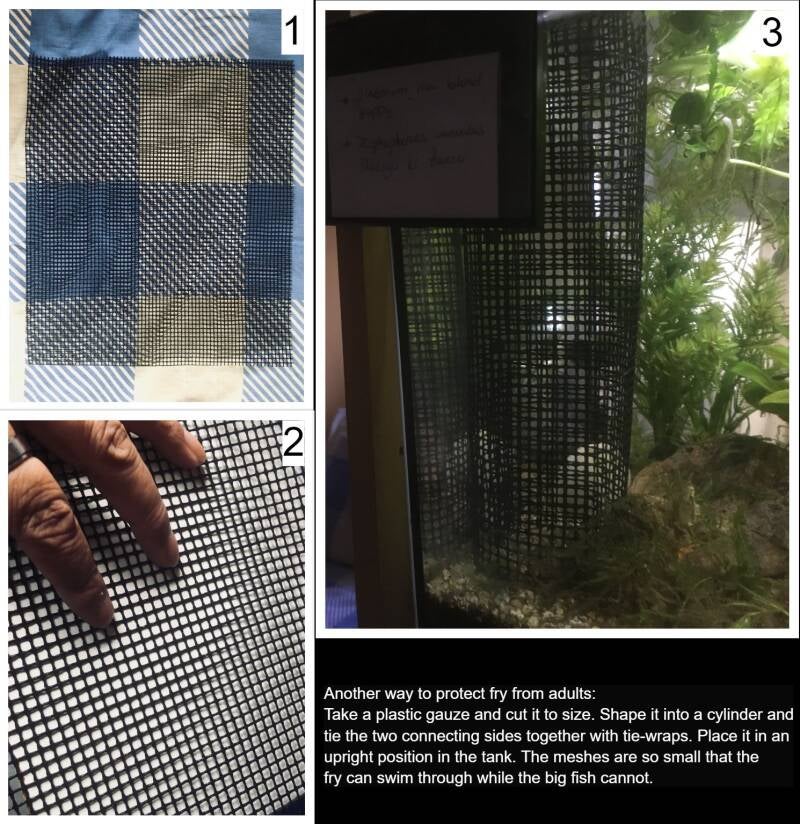
Another way to create a safe place for your fry is a very simple and cheap kitchen utensil. It can be slid over the top of the aquarium glass. And it is also extendable. And they come in many colors. Pick the color that's best suitable. See the pictures below.


Above: One can also use these spheres that are available at flower shops and garden centers. The artificial spheres will float and are hollow from the inside. Fry can seek shelter in there without any chance that adult fish can get to them.
Below: Using an artificial turf tiles or imitation flower tufts that are available at flower shops, garden center and at interior stores can also come in handy. Just roll them as a cylinder and use ty-raps to hold the shape.. Put them in a fishtank in a standing position. This creates also shelter for the fry for the inside is hollow. And adults are too big to swim in.


Above right: It's clear that only the fry or very small fish can swim through this turf tile cylinder.

Above: A floating breeder box is also an option. A lot of people would not choose this option because they think that such an option will stress a pregnant female out. Back in the old'n days, this way of keeping a heavily pregnant female was quite normal. And to be honest, the stress that people are talking about isn't really that present if you know when to put such a pregnant female in. The mistake that many people have made is to put such a female too early in instead of putting her in there when she's almost due. If you put a female too early in, she'll will be too active (a heavily pregnant female is slower) and can drop some immature eggs which won't have any chance on survival. So, those eggs are lost. There are also dual floating breeder boxes available which can house two pregnant females. I myself won't promote the breeder boxes myself for I like to let those pregnant females drop their fry in the tank itself (unless the risk of them getting eaten by other fish is too high).
Another option is to keep them in this breeder box which can be hooked to the top of the fishtank. You can even choose to keep it inside or outside the fishtank. A lid will avoid that a female can jump out.


But there are multiple ways of putting a pregnant female separate from other fish and the same goes for the fry. It's very easy to just put a pregnant female in a bucket. No special needs required. And for the majority of livebearers won't need a heater nor a filter right away when put in a bucket. Once a pregnant female drops her fry, you can remove her once she's done dropping. And to clear, not all female livebearers will eat their fry. When you read forums or homepages, the majority of members and authors of those homepages will tell you that the mothers will eat their fry for sure. To be honest, that's totally incorrect. There are certain livebearer species and strains that will chase and eat their fry. But not all livebearer species will do that. And when it comes to the majority of livebearers, it's a matter of the individual fish wether he/she will eat fry or not. So, no way that every adult livebearer is a fry eater. So please, get it out of your system if you think they're all fry eaters.
Why is a fish bowl not the best choice?
Below:
This illustration shows why it's better not to use a fish bowl. Some gasses may stay longer in the fish bowl while in a straight situation the gasses can escape right away. One can compare the situation with a glass of wine.


